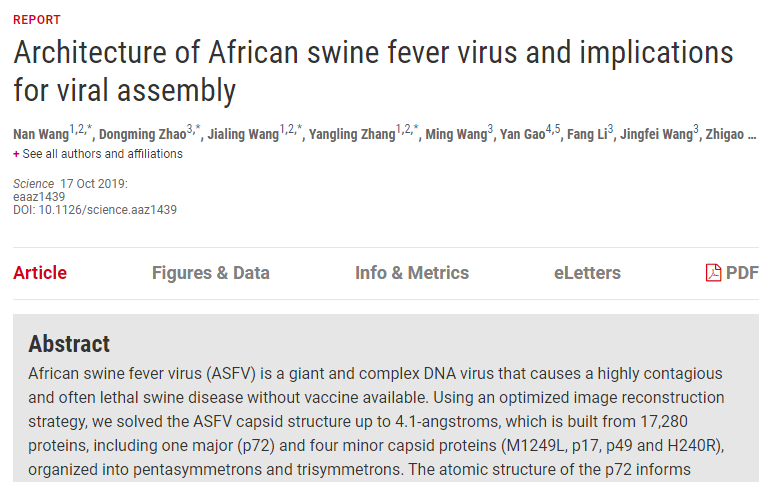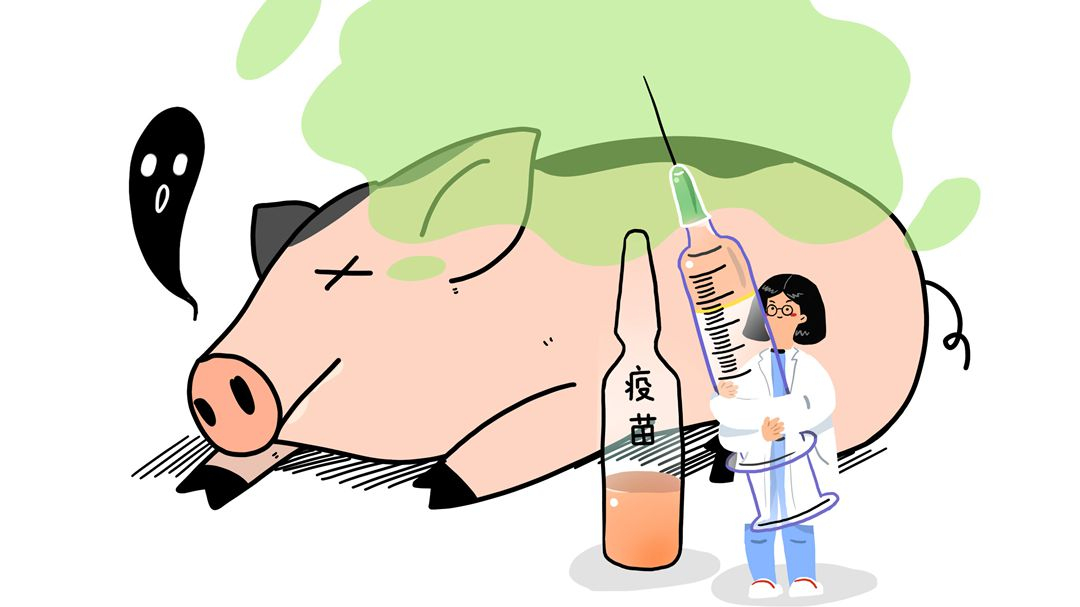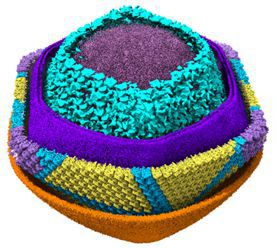Chinese scientists have made a major breakthrough in fighting African swine fever, as their latest research finding unraveled the three-dimensional structure of the virus, laying a solid foundation for developing effective and safe vaccines against the epidemic.
The study, published in the latest issue of the academic journal Science on Thursday, provides important clues to reveal the fundamental mechanisms for the infection of the virus, which has plagued the country for more than a year.

Screenshot from the website of Science.
Screenshot from the website of Science.
China is facing a great challenge in controlling the spread of African swine fever and it is urgent to develop more powerful tools such as a vaccine to prevent the disease, according to the researchers.
The country reported its first case of the disease in August 2018 in the northeastern province of Liaoning. Later outbreaks were reported in other provincial regions, and the total losses in the world's largest pig producer and pork market has reached millions of U.S. dollars.
China has conducted lab researches on the vaccine against the disease, but the vaccines under development are still not perfect, according to Bu Zhigao, director of the Harbin Veterinary Research Institute of CAAS, a member of the research team.
Previous developments of the vaccines used traditional methods, lacking clear theoretical guidance. Recent research may prove beneficial for new designs of the vaccines, Bu said.

China has been conducting lab researches on the vaccine against the African swine fever. /VCG Photo
China has been conducting lab researches on the vaccine against the African swine fever. /VCG Photo
What are the findings?
The research team successfully isolated the epidemic strain of the African swine fever virus, which is spreading in China. It took them four months to collect massive high-quality data.
The research showed the virus has a unique structure of five layers: The outer membrane, capsid, double-layer inner membrane, core-shell, and genome.
It contains more than 30,000 protein subunits, forming a spherical particle with a diameter of about 260 manometers.
The study identified structural proteins of the virus, revealing potential protective antigens and key information on the epitope, the part of an antigen molecule to which an antibody attaches itself.
The research also showed the complex arrangement and interaction mode of the structural proteins and proposed the possible assembly mechanism of the virus, providing an important clue as to how it invades host cells and evades and antagonizes the host antiviral immunity.

The virus has a unique structure of five layers. /Photo from the website of Science.
The virus has a unique structure of five layers. /Photo from the website of Science.
First step in the 'long march' to tackle the disease
The research has been jointly conducted by scientists at the Institute of Biophysics of the Chinese Academy of Sciences (CAS) and the Harbin Veterinary Research Institute of the Chinese Academy of Agricultural Sciences (CAAS), ShanghaiTech University and other institutes.
Rao Zihe, a CAS academician and one of the leading scientists of the research, said unveiling the structure of African swine fever is the first important step in the "long march" to tackle the disease. Researchers will continue to analyze the structure of the virus's core-shell, and how the virus interacts with the receptors.
Wang Xiangxi, a researcher at the Institute of Biophysics of CAS, said the five-layer structure of the African swine fever virus is very rare and more complicated than other viruses.
"The size of the African swine fever virus is huge, it is the largest one among the viruses unraveled by Chinese scientists. Its diameter is 10 times longer than the diameter of the hepatitis A virus," Wang said.
Shao Feng, another CAS academician and deputy director of the National Institute of Biological Sciences, said compared with other viruses, scientists' knowledge about African swine fever is almost zero. Cooperation between scientists including immunologists is needed to push forward vaccine research.
"The unveiled structure of the virus is so exquisite, and the analysis work is so beautiful. I believe it can provide help for not only developing vaccines, but also diagnosis and producing medicine for treating the disease," said Chen Xinwen, head of the Guangzhou Institutes of Biomedicine and Health of the CAS.
How serious is African swine fever?
African swine fever, with an epidemic history of nearly 100 years, is a challenging global problem.
First found in Kenya in 1921, it is a highly contagious viral disease of swine with mortality rates approaching 100 percent. Over the past decade, the disease has spread through many countries, posing a serious risk of further expansion.
During the period from January to October 2019, the World Organization for Animal Health was notified by 26 countries of new or ongoing outbreaks: 13 in Europe, 10 in Asia and three in Africa.
With no vaccine or treatment available, culling pigs is the most effective way to contain the outbreaks, more than 30 million pigs have been culled during 2018 and 2019.
The African swine fever pandemics have caused estimated economic losses of two billion U.S. dollars for swine production worldwide. The African swine fever virus is stable in the environment and transmits rapidly and efficiently among pigs, scientists say.
African swine fever is believed to only infect pigs. No humans or other species are known to have been infected.
(With input from Xinhua)